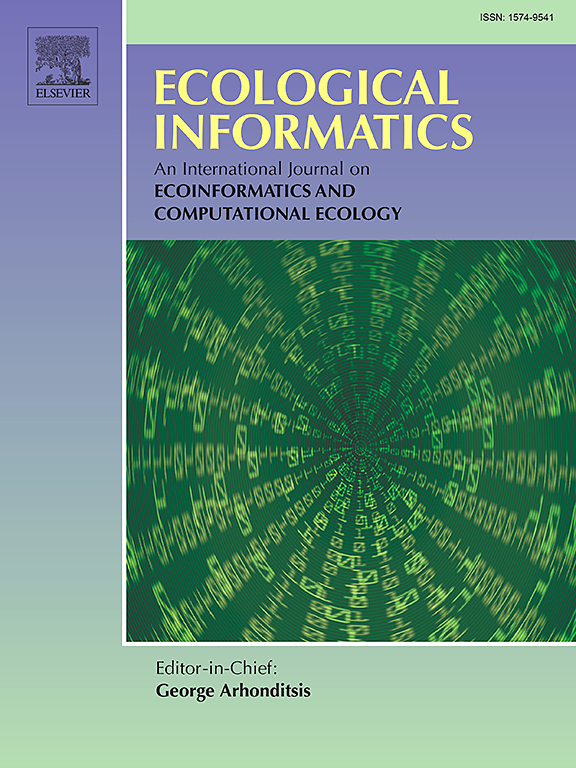评估预测的经验动态模型:时间序列重复间变异的作用
IF 5.8
2区 环境科学与生态学
Q1 ECOLOGY
引用次数: 0
摘要
生态系统的准确预测对有效的环境管理至关重要,但仍然具有挑战性。实现这一目的的一个工具是经验动态建模(EDM)。电火花加工通常需要长时间序列作为输入。为了克服数据限制,通常将来自相似来源(重复)的时间序列组合在一起。虽然已经使用模拟数据评估了具有重复的EDM,但添加时间序列的影响仍未完全了解。在本研究中,我们使用来自Lorenz-63系统、一个三物种食物链和一个四物种Lotka-Volterra竞争模型的模拟数据来评估EDM S-Map算法在不同场景下的性能,采用三种不同的方法来生成时间序列重复,每种重复之间都有不同类型的变化:改变初始条件(场景A),对吸引子的不同部分进行采样(场景B),以及改变控制混沌行为的系统参数(场景C)。我们的研究结果表明,EDM在较长的时间序列中表现更好,但组合重复通常可以补偿较短的时间序列长度,这与之前的结果一致。然而,组合重复间变异的类型和水平都会影响预测的准确性。在方案B中添加复制始终可以改善结果。然而,在情景A和C中(涉及不同的长期行为或瞬态阶段),组合复制可能会抵消这些好处,特别是对于周期性和混沌系统以及大的复制间变化。我们的研究结果表明,并不是所有的时间序列重复都同样适合于改进EDM预测,这突出了仔细选择和组合重复的重要性。本文章由计算机程序翻译,如有差异,请以英文原文为准。
Evaluating Empirical Dynamic Modeling for forecasting: The role of variation among time series replicates
Accurate forecasting of ecological systems is essential for effective environmental management but remains challenging. One tool for this purpose is Empirical Dynamic Modeling (EDM). EDM typically requires long time series as input. To overcome data limitations, time series from similar sources (replicates) are often combined. Although EDM with replicates has been evaluated using simulated data, the impact of adding time series remains not fully understood. In this study, we use simulated data from the Lorenz-63 system, a three-species food chain, and a four-species Lotka–Volterra model of competition to evaluate the performance of EDM’s S-Map algorithm across various scenarios, employing three different approaches to generate time series replicates, each with a different type of variation between the replicates: varying initial conditions (Scenario A), sampling distinct sections of the attractor (Scenario B), and varying the system’s parameter controlling chaotic behavior (Scenario C). Our findings demonstrate that EDM performs better with longer time series, but that combining replicates can often compensate for short time series length, in line with expectations from previous results. However, both the type and level of variation among the combined replicates affect forecasting accuracy. Adding replicates in Scenario B consistently improves outcomes. However, in Scenarios A and C (involving different long-term behaviors or transient phases), combining replicates may negate these benefits, particularly for periodic and chaotic systems and large inter-replicate variations. Our results show that not all time series replicates are equally suitable for improving EDM forecasts, highlighting the importance of careful selection and combination of replicates.
求助全文
通过发布文献求助,成功后即可免费获取论文全文。
去求助
来源期刊

Ecological Informatics
环境科学-生态学
CiteScore
8.30
自引率
11.80%
发文量
346
审稿时长
46 days
期刊介绍:
The journal Ecological Informatics is devoted to the publication of high quality, peer-reviewed articles on all aspects of computational ecology, data science and biogeography. The scope of the journal takes into account the data-intensive nature of ecology, the growing capacity of information technology to access, harness and leverage complex data as well as the critical need for informing sustainable management in view of global environmental and climate change.
The nature of the journal is interdisciplinary at the crossover between ecology and informatics. It focuses on novel concepts and techniques for image- and genome-based monitoring and interpretation, sensor- and multimedia-based data acquisition, internet-based data archiving and sharing, data assimilation, modelling and prediction of ecological data.
 求助内容:
求助内容: 应助结果提醒方式:
应助结果提醒方式:


